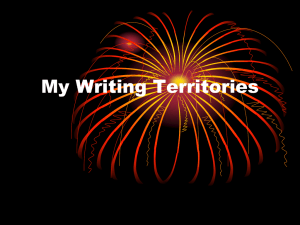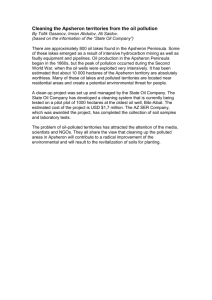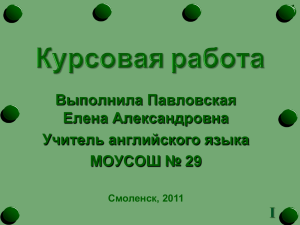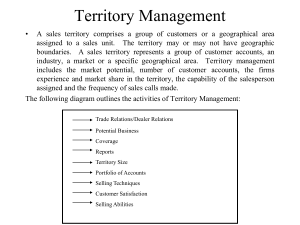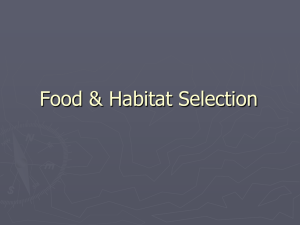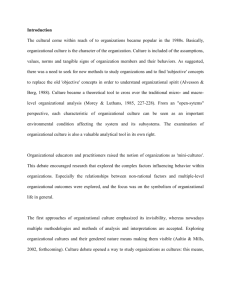Law of the Republic of Uzbekistan "On Especially Protected Natural
advertisement
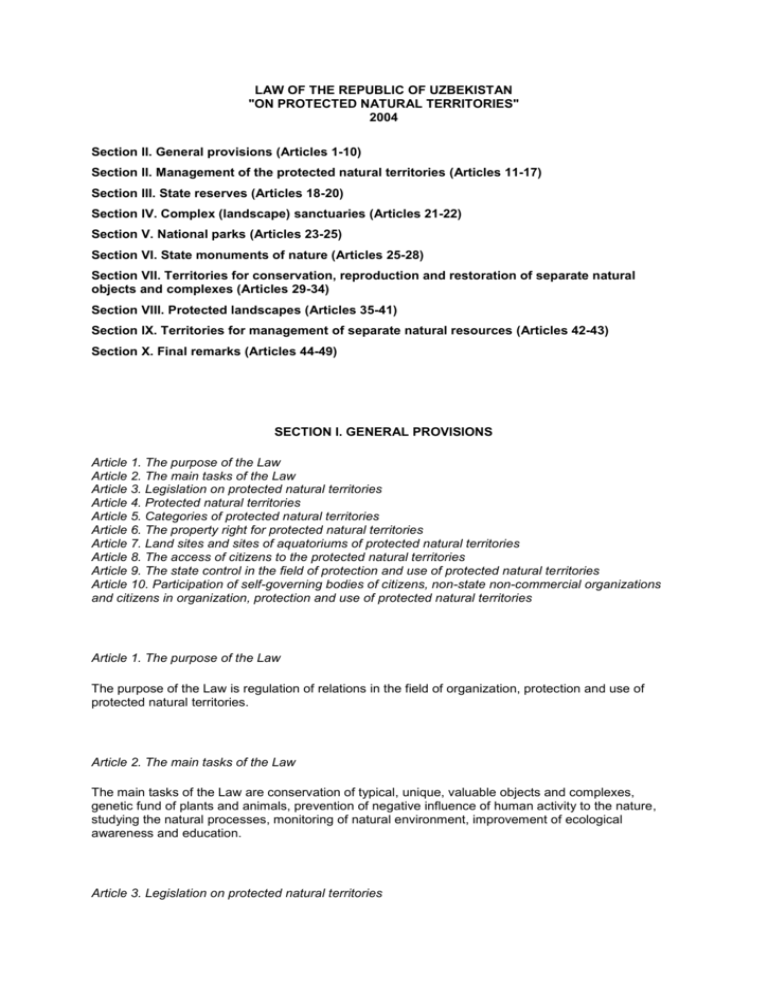
LAW OF THE REPUBLIC OF UZBEKISTAN "ON PROTECTED NATURAL TERRITORIES" 2004 Section II. General provisions (Articles 1-10) Section II. Management of the protected natural territories (Articles 11-17) Section III. State reserves (Articles 18-20) Section IV. Complex (landscape) sanctuaries (Articles 21-22) Section V. National parks (Articles 23-25) Section VI. State monuments of nature (Articles 25-28) Section VII. Territories for conservation, reproduction and restoration of separate natural objects and complexes (Articles 29-34) Section VIII. Protected landscapes (Articles 35-41) Section IX. Territories for management of separate natural resources (Articles 42-43) Section X. Final remarks (Articles 44-49) SECTION I. GENERAL PROVISIONS Article 1. The purpose of the Law Article 2. The main tasks of the Law Article 3. Legislation on protected natural territories Article 4. Protected natural territories Article 5. Categories of protected natural territories Article 6. The property right for protected natural territories Article 7. Land sites and sites of aquatoriums of protected natural territories Article 8. The access of citizens to the protected natural territories Article 9. The state control in the field of protection and use of protected natural territories Article 10. Participation of self-governing bodies of citizens, non-state non-commercial organizations and citizens in organization, protection and use of protected natural territories Article 1. The purpose of the Law The purpose of the Law is regulation of relations in the field of organization, protection and use of protected natural territories. Article 2. The main tasks of the Law The main tasks of the Law are conservation of typical, unique, valuable objects and complexes, genetic fund of plants and animals, prevention of negative influence of human activity to the nature, studying the natural processes, monitoring of natural environment, improvement of ecological awareness and education. Article 3. Legislation on protected natural territories Legislation on protected natural territories consists of this Law and other legislative acts. Relations in the field of organization, protection and use of protected natural territories in the Republic of Karakalpakstan are also regulated by the legislation of the Republic of Karakalpakstan. If international treatment of the Republic of Uzbekistan establishes other rules than those that are established by the legislation of the Republic of Uzbekistan on protected natural territories then the rules of international treatment shall prevail. Article 4. Protected natural territories Protected natural territories are sites of land and (or) water area (aquatoriums) of priority ecological, scientific, cultural, aesthetic, recreational and sanitary-treatment significance, which have been completely or partially, permanently or temporarily withdrawn from economic exploitation. For the purpose of conservation, reproduction and restoration of natural objects and complexes the regime of protection and use (hereinafter referred to as “regime”) shall be established. Protected natural territories constitute the unified ecological system designed for ensuring biological and landscape diversity as well as maintaining ecological balance. Article 5. Categories of protected natural territories Protected natural territories depending on their target purpose and regime are divided to the following categories: - state reserves; complex (landscape) sanctuaries; natural parks; state natural monuments; territories for conservation, reproduction and restoration of separate natural objects and complexes; protected landscapes; territories for management of separate natural resources. Article 6. The property right for protected natural territories Protected natural territories are the property of the state and are protected by it. The land areas and other natural objects can be given for use to legal and physical persons for creation of private sanctuaries and natural nurseries. Article 7. Land sites and sites of aquatoriums of protected natural territories The land sites of protected natural territories refer to the lands of nature protection, sanitary-treatment and recreational purpose. On land sites and sites of aquatorium of protected natural territories any activity contradicting to their target purpose is forbidden. For limitation or prohibition of the activity, which exerts or may exert negative influence on the condition of protected natural territories, the burden of land sites shall be set. At organization of protected natural territories the losses of legal and physical persons caused by limitation or termination of their activity shall be recovered in accordance with the legislation. At allotment of the land of agricultural purpose and forestry fund for creation of protected natural territories the losses of agricultural and forestry production shall not be recovered. The land sites of state reserves, complex (landscape) sanctuaries, natural parks, state natural monuments, sanctuaries (except for sanctuaries created in forestry facilities), and natural nurseries are exempted from taxes. The land tax is collected when there is an economic activity being carried out on protected natural territories. Withdrawal of land sites of protected natural territories for state and public needs is allowed in exceptional cases. In cases when legal or physical persons do not ensure assigned to them responsibilities on protection of state nature monuments, sanctuaries and natural nurseries, the land site, which is occupied by them, can be withdrawn. The order of protection, use and withdrawal of land sites and sites of aquatoriums of protected natural territories shall be established by the legislation. Article 8. The access of citizens to the protected natural territories The protected natural territories are generally accessible for citizens, except for the cases, established by the present Law. For the purpose of protection of rare and endangered species of plants and animals, environment of their growth and habitat, the access of citizens to the separate parts of protected natural territories can be limited or forbidden by state bodies, legal and physical persons under whose authority these territories locate. The access of citizens to the protected natural territories is carried out in accordance with the rules of visiting of these territories, approved by specially authorized state bodies. In the order, established by the Cabinet of Ministers of the Republic of Uzbekistan, the access of citizens to the separate protected natural territories can be carried out on a paid basis. Historically developed residence of the population on separate protected natural territories can be retained with a condition of observance of their regime. Article 9. The state control in the field of protection and use of protected natural territories The state control in the field of protection and use of protected natural territories is carried out by the State Committee of the Republic of Uzbekistan for Nature Protection, as well as by local public authorities. Article 10. Participation of self-governing bodies of citizens, non-state non-commercial organizations and citizens in organization, protection and use of protected natural territories Self-government institutions of citizens, not state noncommercial organizations and citizens assist the state bodies in carrying out of the measures on organization, protection and use of protected natural territories. The state bodies at carrying out of these measures are taking into account the proposals of self-government institutions of citizens, non-state non-commercial organizations and citizens. For the purpose of attraction of population to the management of separate protected natural territories among the representative bodies of citizens’ self-government institutions, non-state noncommercial organizations as well as citizens, the advisory commissions can be created by the decision of the local government authority. The decisions on creation of protected natural territories and their security zones, which affect the interests of the population living in these territories, shall be accepted by taking into account conclusions made by advisory commissions. Self-government institutions of citizens, non-state non-commercial organizations and citizens have the right to request and receive the information on protected natural territories from the corresponding state bodies. Self-government institutions of citizens, non-state non-commercial organizations and citizens can carry out public ecological expertise and public ecological control during organization, protection and use of protected natural territories in the order established by the legislation. SECTION II. MANAGEMENT OF THE PROTECTED NATURAL TERRITORIES Article 11. State management of protected natural territories Article 12. Reservation of land sites for organization of protected natural territories Article 13. Creation, reorganization and termination of functioning of protected natural territories Article 14. State cadastre of protected natural territories Article 15. Passport of protected natural territories Article 16. Plan of management of protected natural territories Article 17. Organization of protected natural territories Article 11. State management of protected natural territories The state management in the field organization, protection and use of protected natural territories is carried out by the Cabinet of Ministers of the Republic of Uzbekistan, local government authorities, as well as by specially authorised bodies. Article 12. Reservation of land sites for organization of protected natural territories For the purpose of organization of protected natural territories on the proposal of specially authorized state bodies, as well as legal and physical persons the reservation of protected natural territories is being made by the decision of local government authorities. The activity of legal and physical persons on reserved land sites, which threatens conservation of designated for protection natural objects and complexes should be limited or prohibited. Granting for ownership and use of these land sites or for rent to legal and physical persons is allowed only if there is a positive conclusion made by state ecological expertise. Protected natural territories shall be considered during development of plans and programs, schemes of land utilization and district planning, as well as other plans on protection of and use of natural resources. Article 13. Creation, reorganization and termination of functioning of protected natural territories Protected natural territories are created by the decision of the Cabinet of Ministers of the Republic of Uzbekistan and local government authorities in the order established by the legislation. Reorganization of protected natural territories is carried out when there is a need for changing their categories. It is provided that converting of the protected natural territories from the category of stricter regime to the category of less strict regime is allowed in exceptional cases. Termination of the functioning of protected natural territories is carried out at the expiration of the period to which they have been organized, as well as when there will be a loss of value and uniqueness of their natural objects and complexes as a result of natural disasters and man-caused actions. Article 14. State cadastre of protected natural territories The state cadastre of protected natural territories contains the information on categories and types of these territories, their geographical position, quantitative and qualitative characteristics, ecological, economical, scientific, educational and other value, landowners, land users, as well as lessee and owners of the land sites. The state cadastre of protected natural territories is kept with the purposes of ensuring the regime, conducting scientific researches, registration of these territories during planning of development and distribution of production capacities. The state cadastre of protected natural territories is kept by the State Committee of the Republic of Uzbekistan on Protection of Nature jointly with Academy of Science of the Republic of Uzbekistan at the expense of State budget of the Republic of Uzbekistan in the order established by the legislation. Article 15. Passport of protected natural territories The state bodies, legal and physical persons, which have the protected natural territories under their authority, have to make a passport on each territory where the information characterizing this territory, its regime and management shall be specified. The order of keeping the passport of protected natural territories shall be established by the Cabinet of Ministers of the Republic of Uzbekistan. Article 16. Plan of management of protected natural territories The plans of management of protected natural territories constitute the complex of organizational, nature protection, technical and other measures on protection and use of natural objects and complexes. The plans of management of protected natural territories are established by the state bodies, legal and physical persons who have the protected natural territories under their authorities. The draft plans of management of protected natural territories are subject to state ecological expertise. The order of designing of the plans of management of protected natural territories is established by the State Committee of the Republic of Uzbekistan on Protection of Nature. Article 17. Organization of protected natural territories The protection of state reserves, complex (landscape) sanctuaries, natural parks and state biospheric reserves is carried out by security guards and is regulated by the provisions on indicated protected natural territories. The security guard workers are included into the staff of state reserves, complex (landscape) sanctuaries, natural parks and state biospheric reserves and use all rights and privileges of the state inspectors on protection of nature. The protection of state reserves and natural nurseries is carried out by legal persons on whose land sites they locate. The protection of state nature monuments is carried out by legal and physical persons on whose land sites they locate. If state sanctuaries and state nature monuments locate on the land sites, which were not given to legal and physical persons, the ensuring of their protection shall be entrusted to local government authorities and specially authorised state bodies. Protection of water protected zones, riversides and zones of formation of surface and underground waters is carried out by the bodies of agricultural and water resources, legal and physical persons, on the land sites where they have been created. Zones of sanitary protection of water objects are protected by bodies of internal affairs. Protection of resort natural territories and recreation zones is ensured by local government authorities. Territories for management of separate natural resources are protected by forestry protection service and hunting facilities service. Protection of fishery zones is ensured by legal and physical persons involved in fishery and bodies of nature protection. Protection of private sanctuaries and nature nurseries is ensured by legal and physical persons under whose authority they locate. Protected zones are protected by state bodies, legal and physical persons which have been entrusted to protect state reserves, sanctuaries and state nature monuments. SECTION III. STATE RESERVES Article 18. Creation of the state reserves Article 19. Regime of the state reserves Article 20. Scientific and research activity in the state reserves Article 18. Creation of the state reserves The state reserves are protected natural territories of general public significance with strict regime of protection of natural objects and complexes designated for conservation and study of typical ecological systems, genetic fund of plants and animals. The state reserves are created in the form of state nature protection scientific and research establishment by the decision of the Cabinet of Ministers of the Republic of Uzbekistan on proposals made by specially authorized state body. The state reserves act on the basis of Provision established by the Cabinet of Ministers of the Republic of Uzbekistan. Article 19. Regime of the state reserves Any activity on the territory of the state reserves, except for scientific and research activity and monitoring of natural environment, is forbidden. It is allowed to carry out fire prevention measures in the state reserves. It is forbidden to plant new species or subspecies of living organisms for the purpose of their acclimatization on the territory of the state reserves and their protected zones. Residing of the citizens in the territory of state reserves, who are not the workers of state reserves or state bodies, under whose authority they locate, is allowed only if they have permission given by these bodies or administration of state reserve. Article 20. Scientific and research activity in the state reserves Scientific researches in the state reserves are carried out by staff scientific workers. The other scientific organizations and specialists can be attracted on contractual basis. The scientific councils are created in the state reserves. Monitoring of natural environment is obligatory in state reserves. The results of scientific and research activity in the state reserves obtained at the expense of State budget of the Republic of Uzbekistan and funds of nature protection are the property of the government. The right of property for the results of scientific and research activity obtained at the expense of legal and physical persons is established by the agreement between the state reserves and above mentioned persons. The state reserves use the results of scientific and research activity free of charge. Scientific information on condition of natural objects and complexes of state reserves is subject to publication. The state reserves can have own publishing editions. Scientific funds of state reserves are subject to permanent storage. The coordination of scientific researches of state reserves is carried out by the Academy of Sciences of the Republic of Uzbekistan. SECTION IV. COMPLEX (LANDSCAPE) SANCTUARIES Article 21. Creation of complex (landscape) sanctuaries Article 22. Regime of complex (landscape) sanctuaries Article 21. Creation of complex (landscape) sanctuaries The complex (landscape) sanctuaries are protected natural territories designated for conservation in natural condition of the natural objects and complexes, which have special ecological value. The complex (landscape) sanctuaries are created in the form of state nature protected establishment by the decision of the Cabinet of Ministers of the Republic of Uzbekistan on proposal made by the specially authorized state body. The complex (landscape) sanctuaries are acting on the basis of the Provision approved by the Cabinet of Ministers of the Republic of Uzbekistan. Article 22. Regime of complex (landscape) sanctuaries Any activity on the territory of complex (landscape) sanctuaries except for scientific and research, recreational activity, monitoring of natural environment, as well as moving (grass cutting) and cattle pasturing, preparation (collection) of wild-growing plants for food purposes, wild-growing planting medical and technical raw material for private needs of the workers of complex (landscape) sanctuaries and citizens living in their protected zones, is forbidden. SECTION V. NATIONAL PARKS Article 23. Creation of natural parks Article 24. Territories of natural parks Article 25. Regime of natural parks Article 23. Creation of natural parks The natural parks are protected natural territories designated for conservation and use in nature protection, recreational, scientific and cultural purposes of the natural objects and complexes, which have special ecological, cultural and aesthetic value. The natural parks are divided into national natural parks and natural parks of local significance, which are created in the form of state nature protection establishment correspondingly by the decision of the Cabinet of Ministers of the Republic of Uzbekistan on presentation of specially authorized state body. The natural parks are acting on the basis of Provisions approved by the state bodies under whose authority they locate. Article 24. Territories of natural parks The territories of natural parks locate on the land sites given to natural parks for use, as well as on the land sites of other legal and physical persons that situate within the borders of natural parks. At creation of the natural parks the zoning of their territories shall be made. On the territory of natural parks the reserve zones, the zones of recreational, economic and other use are allocated. In the presence of conditions for health-improving of the population in the natural parks the resort zones with regime of resort natural territories shall be allocated. The change of sizes and borders of zones of natural parks is carried out by the public authorities under whose authority they locate by taking into account the conclusion of the state ecological expertise. Article 25. Regime of natural parks On the territory of natural parks a diversified regime in accordance with the zoning is established. On reserved zones of natural parks the regime applied to state reserves shall be established. The recreational zones of natural parks depending on the condition of natural objects and complexes can be divided into the areas with different regimes. In the zones of economic and other use of natural parks the residence of population and the activity of legal and physical persons, which do not cause damage to natural objects and complexes, is allowed. The regime of each zone is determined by the Provisions on natural parks. On the territory of natural parks the following is forbidden: - cutting of wood and shrubby plantings (except for cutting for maintenance and sanitary); - activities changing a hydrologic and hydro-geological regime; - activities causing erosion of soils, degradation of fauna and flora; - implementation of road and engineering and communication works, not connected to the activity of natural parks; - storage and burial of wastes, sewage disposal; - settling new species and subspecies of living organisms with the purpose of acclimatization. Other types of activity in the natural parks that may cause damage to the natural objects and complexes can be forbidden or limited. In cases, when the construction of roads, other communications and structures is necessary for normal functioning of natural parks, the revegetation of damaged lands and carrying out of a complex of nature protection measures shall be obligatorily foreseen. SECTION VI. STATE MONUMENTS OF NATURE Article 26. Types of state monuments of nature Article 27. Declaration of natural objects as state monuments of nature Article 28. Regime of state monuments of nature Article 26. Types of state monuments of nature The state monuments of nature are protected natural territories having unique, irreplaceable, valuable natural objects of ecological, scientific, cultural and aesthetic significance. The state monuments of nature are divided into the following types: - hydrological (marsh, lake, river and other) designated for conservation of natural water objects; botanical, designated for conservation of separate plants; geomorphologic, designated for conservation of forms of relief created by the nature; paleonthologic, designated for conservation of fossil objects; geological and mineralogical, designated for conservation of geological and mineralogical formations. Article 27. Declaration of natural objects as state monuments of nature The natural objects are declared as the state monuments of nature by local public authorities on presentation of specially authorized body, as well as on request of legal and physical persons. Declaration of natural objects as the state monuments of nature is allowed without withdrawal of the land sites where they locate. Article 28. Regime of state monuments of nature Any activity on the territory of state monuments of nature, which threatens its conservation, is forbidden. The obligations on ensuring the regime of state monuments of nature are entrusted on legal and physical persons on the land sites where they locate. The state monuments of nature, used by the population in cult purposes, can be granted for use or lease to religious organizations or physical persons under the condition of carrying out of works on their development and conservation. SECTION VII. TERRITORIES FOR CONSERVATION, REPRODUCTION AND RESTORATION OF SEPARATE NATURAL OBJECTS AND COMPLEXES Article 29. Types of territories for conservation, reproduction and restoration of separate natural objects and complexes Article 30. Sanctuaries Article 31. Creation of sanctuaries Article 32. Regime of sanctuaries Article 33. Natural nurseries Article 34. Fishery zones Article 29. Types of territories for conservation, reproduction and restoration of separate natural objects and complexes The territories for conservation, reproduction and restoration of separate natural objects and complexes are created in the form of sanctuaries, natural nurseries and fishery zones. Article 30. Sanctuaries Sanctuaries are protected natural territories designated for conservation, reproduction and restoration of separate natural objects and complexes. Sanctuaries are divided into the following types: - - biological (botanical, zoological) designated for conservation, reproduction and restoration of valuable, rare and endangered species of plants and animals, ways of migration of living organisms; paleonthologic, designated for conservation of fossil objects and their complexes; hydrological (marsh, lake, river and other) designated for conservation of valuable water objects; geological and mineralogical, designated for conservation of geological and mineralogical formations. The sanctuaries may be of general public and local significance. Article 31. Creation of sanctuaries The sanctuaries of general public significance are created by the decision of the Cabinet of Ministers of the Republic of Uzbekistan on presentation of specially authorized state body, as well as on request of legal and physical persons. The sanctuaries of local significance are created by the decision of local public authorities on presentation of specially authorized state body, as well as on request of legal and physical persons. The sanctuaries are created without specifying of the period of functioning (permanent) or for the period of not less than ten years. The sanctuaries may be public and private with or without initiating of legal person status. For creation of private sanctuaries and state sanctuaries with initiation of legal person status the land sites and separate natural objects shall be granted in the established order. Article 32. Regime of sanctuaries Any activity that may cause damage to separate natural objects and complexes on the territory of sanctuaries, except for complex (landscape) sanctuaries, shall be permanently or temporary limited or terminated. The territories where the state sanctuaries locate without initiating the legal person’s status shall not be withdrawn from economic use of landowners, land users, as well as lessees and owners of land sites. Legal and physical persons, on whose land sites and (or) aquatoriums these sanctuaries are created, are obliged to observe the established regime of sanctuaries. The peculiarities of the regime of each sanctuary are determined by the Provision, approved by the state bodies, legal and physical persons, under whose authority the sanctuaries locate. Article 33. Natural nurseries The natural nurseries are the protected natural territories designated for conservation, reproduction and restoration of separate species of plants and animals by creation of necessary conditions for them. The natural nurseries are created by the decisions of local government bodies on request of legal and physical persons. The natural nurseries may be public and private, with or without initiating of legal and physical persons’ status. For creation of the private natural nurseries and the state natural nurseries with initiation of legal person’s status the land sites and separate natural objects shall be granted in the established order. Any activity on the territory of natural nursery that may cause damage to conservation, reproduction and restoration of plants and animals to which this nursery is designated for is forbidden. Article 34. Fishery zones Fishery zones are the protected natural territories, which include water objects or their parts, used for conservation, reproduction and restoration of rare and endangered species of fishes and other water organisms, as well as for fishery needs. The fishery zones are created by the decision of the Cabinet of Ministers of the Republic of Uzbekistan on presentation of bodies on protection of nature, agriculture and water resources. Any activity in the fishery zones that may cause damage to conservation, reproduction and restoration of fishes and other water organisms is forbidden. SECTION VIII. PROTECTED LANDSCAPES Article 35. Types of protected landscapes Article 36. Resort protected landscapes Article 37. Regime of resort protected landscapes Article 38. Recreational zones Article 39. Regime of recreational zones Article 40. Water protected zones, riversides, zones of sanitary protection of water objects and zones of formation of surface and underground waters Article 41. Regime of water protected zones, riversides, zones of sanitary protection of water objects and zones of formation of surface and underground waters Article 35. Types of protected landscapes Protected landscapes include resort natural territories, recreational zones, water protected zones, riversides, zones of sanitary protection of water objects and zones of formation of surface and underground waters. Article 36. Resort protected landscapes Resort natural territories are protected natural territories, which posses medical and treatment properties that have mineral sources, deposits of medical dirt, favourable climatic and other conditions. Resort natural territories can be of general public and local significance. Resort natural territories of general public significance are created by the decision of the Cabinet of Ministers of the Republic of Uzbekistan on joint proposal of the Council of Federation of Trade Unions of Uzbekistan and the Ministry of Public Health Services of the Republic of Uzbekistan. Resort natural territories of local significance are created by the decision of local public authorities on joint proposal of the Council of Federation of Trade Unions of Uzbekistan and the Ministry of Public Health Services of the Republic of Uzbekistan. Article 37. Regime of resort protected landscapes Resort natural territories are divided into three zones. The first zone includes the territories occupied by medical sources and deposits of medical dirt. In this zone any economic activity, except for construction of structures necessary for allocation of medical sources and institutions for mud-cures, is forbidden. The second zone includes the territories of sanatoriums, boarding-houses and rest houses. Any activity in this zone, except for the activity necessary for organization of treatment and rest, as well as residing of population, but not the temporary residing of medical and attending personal, is forbidden. The third zone includes the territories bordering with sanatoriums, boarding-houses and rest houses. In this zone the limited economic activity, which does not cause the damage to medical sources, deposits of medical dirt, and does not worsen the conditions for resting and treatment, is allowed. Within the limits of resort natural territories the following is forbidden: - extraction of minerals, except for mineral water and medical dirt; activity of the enterprises of chemical, pulp and paper and metallurgical industry; cutting of wood and shrubby plantings (except for sanitary and maintenance cutting); application of poisonous chemicals; organization of cattle burial; organization of warehouses of poisonous chemicals and mineral fertilizers; storage and burial of wastages; change of hydrological regime of territory. Article 38. Recreational zones Recreational zones are protected natural territories with geographical and climatic conditions, suitable for organization of tourism and mass resting of the population. Recreational zones are created by the decision of local public authorities on joint proposal of the Council of Federation of Trade Unions of Uzbekistan and the Ministry of Public Health Services of the Republic of Uzbekistan. Article 39. Regime of recreational zones The recreational zones depending on the conditions of natural objects and complexes can be divided into the areas with different regimes. The following is forbidden in recreational zones: - activity of the enterprises of chemical, pulp and paper and metallurgical industry; cutting of wood and shrubby plantings (except for sanitary and maintenance cutting); application of poisonous chemicals; organization of cattle burial; storage and burial of wastages; change of hydrological regime of territory. Article 40. Water protected zones, riversides, zones of sanitary protection of water objects and zones of formation of surface and underground waters Water protected zones are protected natural territories, adjusting to riverbeds, lakes, reservoirs, channels, collectors and other water objects. These zones are created for the purpose of prevention of pollution, contamination, exhaustion and silting of water objects by products of soil erosion, as well as for maintenance of favourable water regime. The riversides are protected natural territories within the limits of water protected zone with strict regime. Zones of sanitary protection of water objects are protected natural territories with strict regime, adjusted to the water objects, which are used for drinking, living and sanitary treatment needs. Zones of formation of surface and underground waters are the protected natural territories, created in river valleys, debris cones, submountain tail area. The water protected zones, riversides, zones of sanitary protection of water objects and zones of formation of surface and underground waters are created by the decisions of the Cabinet of Ministers of the Republic of Uzbekistan and local government authorities on the proposal of bodies on protection of nature, agricultural and water resources, sanitary service, geological organizations. Article 41. Regime of water protected zones, riversides, zones of sanitary protection of water objects and zones of formation of surface and underground waters Within the borders of water protected zones the limited economic activity is allowed. Within their border the following is forbidden: - cutting of wood and shrubby plantings (except for sanitary and maintenance cutting); application of poisonous chemicals; organization of warehouses of poisonous chemicals and mineral fertilizers; organization of cattle burial; storage and burial of wastages; organization of sewage disposal plants and sewage ponds; placement of cattle breading and poultry complexes, as well as use of liquid manure for irrigation; parking, fuelling, washing and repair of motor transport; organization of oil products storage; washing of linen, ambary, leather. In riversides, besides the limitations and prohibitions indicated in the first part of this article, the following is forbidden: - use of mineral and organic fertilizers; cattle pasturing; any type of construction, except for construction of water objects; - organization of boat docks outside established areas. Zones of sanitary protection of water objects are divided into the protection zones with different regimes. Change of river channels, mining operations and other works influencing the condition of water objects are allowed only by permissions granted by authorities on protection of nature, agriculture and water resources, as well as by geological enterprises. During implementation of inter-economic land utilization and planning of territories of populated area the change of borders of water protected zones, riversides and zones of sanitary protection of water objects must be agreed upon with authorities on protection of nature, agriculture and water resources, and sanitary inspection. The regime of water protected zones and riversides is also applied to zones of formation of surface and underground waters. The order and the conditions of protection and use of water protected zones, riversides, zones of sanitary protection of water objects and zones of formation of surface and underground waters are established by the Cabinet of Ministers of the Republic of Uzbekistan. SECTION IX. TERRITORIES FOR MANAGEMENT OF SEPARATE NATURAL RESOURCES Article 42. Types of territories for management of separate natural resources Article 43. Regime of territories for management of separate natural resources Article 42. Types of territories for management of separate natural resources The territories for management of separate natural resources include the lands of forestry fund, occupied with erosion-preventive woods, city woods, woods around the green zones of the cities, other populated areas and industrial centers, especially valuable woods, woods of walnut-field zones, wood-fruit plantings, woods of scientific or historical significance, as well as land sites of hunting facilities designated for rational use of flora and fauna. Article 43. Regime of territories for management of separate natural resources On the territories for management of separate natural resources the settlement of new species and subspecies of living organisms for the purpose of their acclimatization and other activity, which may cause damage to flora and fauna, is forbidden. On the territories for management of separate natural resources the use of flora and fauna is allowed in the order established by the legislation. SECTION X. FINAL REMARKS Article 44. State biospheric reserve Article 45. Intergovernmental protected natural territories Article 46. Protected zones Article 47. Financing of protected natural territories Article 48. Solution of disputes Article 49. The responsibility for infringement of the legislation on protected natural territories Article 44. State biospheric reserve For the purpose of steady economic and social development of territories the state biospheric reserves can be created – that is protected natural territories designated for conservation of a biological diversity, rational use of natural objects and complexes. The state biospheric reserves can be included in the international network biospheric reserves and participate in global monitoring of natural environment. The state biospheric reserves are created by the decision of the Cabinet of Ministers of the Republic of Uzbekistan. The territories of state biospheric reserves locate on the land sites, which have been given to them for use, as well as on land sites of other legal and physical persons located within the borders of the state biospheric reserves. On the territories of state biospheric reserves the following zones are allocated: - reserve zone, designated for conservation in natural conditions of natural objects and complexes, with the regime applied to national parks; - the buffer zone, designated for conservation, reproduction and restoration of natural objects and complexes, where any activity that may negatively influence reserve zone is forbidden; - transition zone, designated for carrying out of economic and other activity, which does not cause the damage to natural objects and complexes of the state biospheric reserves. The regime of state biospheric reserves is defined by the provisions on them approved by the Cabinet of Ministers of the Republic of Uzbekistan. Article 45. Intergovernmental protected natural territories Intergovernmental protected natural territories are the protected natural territories located on the territory of two and more countries. Intergovernmental protected natural territories can be created on the basis of international agreements of the Republic of Uzbekistan. The regime of intergovernmental protected natural territories is defined in accordance with the legislation and international agreements of the Republic of Uzbekistan. Article 46. Protected zones Protected zones are the territories adjoining (bordering) to state reserves, sanctuaries and monuments of nature. Within the protected zones the economic and other activity is limited or forbidden with the purpose of prevention from the negative influence on these protected natural territories. The sizes of protected zones and their regime, as well as burden of land sites are established simultaneously with creation of protected natural territories. The part of protected zone of the state reserve can be transferred to it for organization of ecological tourism, creation of natural nurseries for growing of rare and endangered species of plants and animals that are peculiar for this territory, and other needs of reserve. Article 47. Financing of protected natural territories State reserves, complex (landscape) sanctuaries and natural parks are financed at the expense of: - means of state budget of the Republic of Uzbekistan; - means of nature protection funds; - incomes from scientific-research, nature protection, advertising-publishing and educational activity; - receipts as compensation for damage caused to protected natural territories; - sums of penalties collected for infringement of regime of protected natural territories; - sums received from realization of confiscated instruments of hunting and fishery, from sale of illegally gained production; - charitable contributions of legal and physical persons; - other receipts, which are not forbidden by the legislation. Besides the means indicated in the first part of this article, the means received from granting permissions for citizens’ access to protected natural territories and use of natural resources, incomes from recreational, tourism-excursion and other activity under whose authority these protected natural territories locate are also go to the disposal of complex (landscape) sanctuaries and natural parks. The means for organization, protection and use of state sanctuaries, state monuments of nature are allocated by local government bodies, public authorities under whose authority the indicated protected natural territories are located. The private sanctuaries and natural nurseries are financed at the expense of legal and physical persons under whose authority they locate. The receipts as compensation for the damage caused to protected natural territories, the sums of penalties collected for infringement of regime of protected natural territories, the means received from granting permissions for citizens’ access to protected natural territories and use of natural resources, incomes from recreational, tourism-excursion and other activity, charitable contributions of legal and physical persons are used for conservation, reproduction and restoration of natural objects and complexes. Article 48. Solution of disputes The disputes in the field of organization, protection and use of protected natural territories shall be resolved in the order established by the legislation. Article 49. The responsibility for infringement of the legislation on protected natural territories The persons that are guilty for infringement of the legislation on protected natural territories bear the responsibility in established order. The President of the Republic of Uzbekistan I.Karimov

